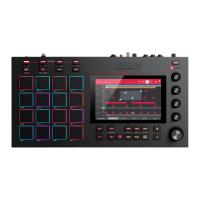504
External Keyboard Routing
MIDI Output Port: This determines the MIDI port where the keyboard will output MIDI externally.
Keyboard sends MIDI here: Check this box to send all MIDI from the keyboard to the selected MIDI Output
port.
MIDI Channel: This determines which MIDI channel (1–16) the keyboard will use to send messages
externally.
Minimum Note / Maximum Note: This determines the range of notes that will output MIDI externally.
Keyboard Settings
Velocity Response: This determines how playing the keys translates into velocity values. Select preset Light
1–3, Linear, or Heavy 1–3 responses, or select Custom to create your own response using the following
settings:
Velocity Curve: Use this slider to adjust the velocity curve, from -50 to 0 to +50. At negative values, it
takes more force to hit higher velocity values; at positive values, it takes less force.
Gain: Use this slider to apply additional gain to the velocity curve, from -20 to 0 to +20. Increasing the
gain will make it easier to hit high velocity values, and decreasing it will make it harder.
Black Key Sensitivity: Use this slider to set the sensitivity of the keyboard’s black keys, from -20 to 0 to
+20.
White Key Sensitivity: Use this slider to set the sensitivity of the keyboard’s white keys, from -20 to 0 to
+20.
Pedal Settings
Pedal: This determines the pedal input port from MPC Key 61. Select Sustain, FS2, or Expression.
Type: This determines the pedal type, either Switch (on/off) or Variable (such as an expression pedal).
Polarity: This determines the polarity of the pedal input. Select
Auto, Positive, or Negative. If you are
having issues with your pedal, check the settings on your hardware or try adjusting this field for the correct
behavior.
CC Assign: This is the MIDI CC assignment the pedal will send. Select Disable, Default (varies depending
on the port used), or CC 000–126.
Pitch Bend / Mod Wheel
Pitch Bend: Use this field to select the MIDI function for the keyboard pitch wheel. Select Disable, Default –
Pitch Bend, or CC 000–126.
Mod Wheel: Use this field to select the MIDI function for the keyboard modulation wheel. Select Disable,
Default – CC 001: Modulation, or CC 000–126.
Global Pitch Bend Settings
Global Pitch Bend: Check this box to override the pitch bend settings of all programs, so that those with
pitch bend disabled or set to different ranges will only use the Global Range instead. When unchecked, all
programs may use their individual pitch bend settings.
Range Up/Range Down: Use these sliders to set the range of the pitch bend in semitones.

